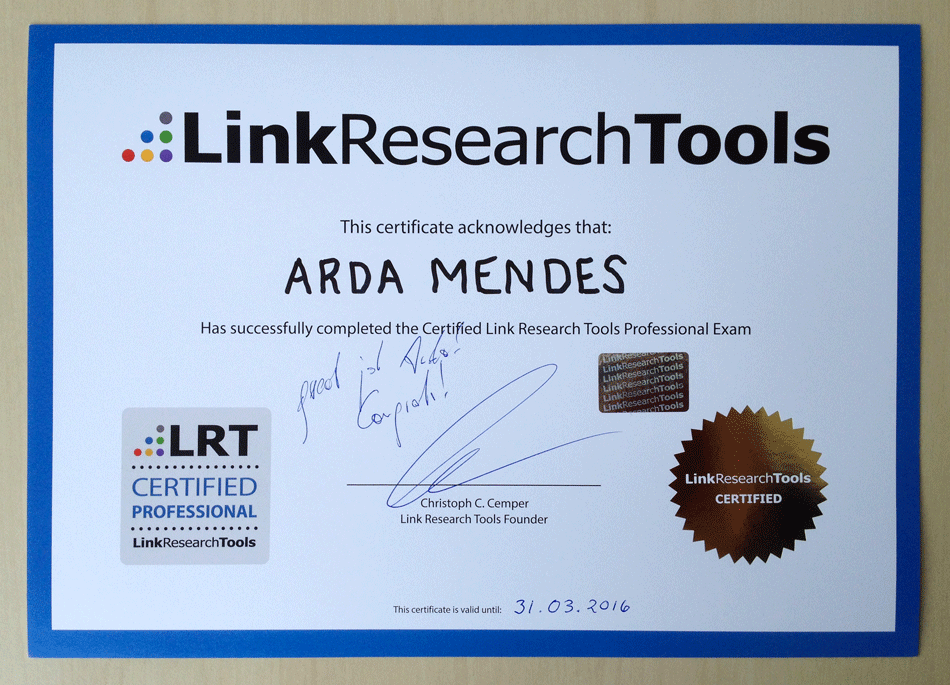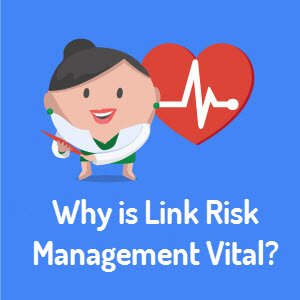Why is Link Risk Management Vital?
Why is maintaining your backlink profile so important to protect your Website?
In SEO, change is constant. It’s evolved from a wild bag of tricks into a refined and complicated profession. Looking back on the evolution of SEO, we see its growing importance. The SEO conferences and graduate course offered across the world prove it. If you need tips on how to sell your client on Link Risk Management, then this article will help. No longer is mere about increasing your rankings as fast as possible. Now SEO aims to protect your hard-fought gains from algorithm changes and malicious actions. Nowadays, online marketing managers explain that SEO is an investment tool. The question your clients ask - What is in it for me? - has an easy answer. The answer is more traffic brings more money.
Enjoy & Learn Christoph C. Cemper
Why is SEO an investment?
With a growing online market, entrepreneurs, small and medium sized enterprises (SMEs), and large-scale companies are allocating budgets for SEO because it’s now an investment instead of an expenditure. SEO is no longer an option. It’s the new normal. Those who consider SEO an expenditure will become the losers. Following the completion of market analysis, the performance of a company in search engines and the performance of its rivals can be compared. The gap between these performances opens the door to potential revenue. When the company has been aligned with the target audience, the negative difference between them stimulates the steps to be taken for gaining more profit.
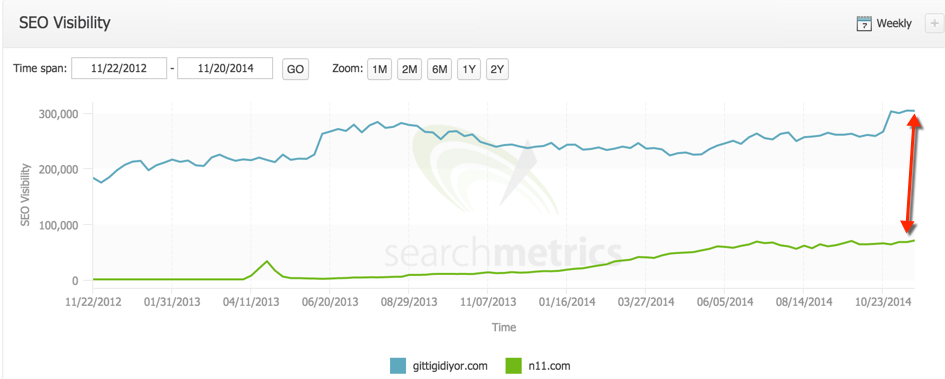
The graph above demonstrates the gap between marketplace websites Gittigidiyor.com (e-bay) and N11.com, both of which serve in Turkey. All leading online marketing managers recognize that SEO is a long-term process. Sticking to it and making continuous efforts for high performance makes this field an investment.
Link Risk Management protects potential, too!
After recognizing the potential performance and identifying the difference between market shares, the negative difference would be engaging. At this point, a situation goes unnoticed! Not only is SEO an investment tool, but it’s also an art of protecting your existence. Google keeps itself alive by continuously improving how it provides quick and exact search results. Therefore, algorithms emerge with its updates, changing how search results look and punishing black hat SEO practitioners.
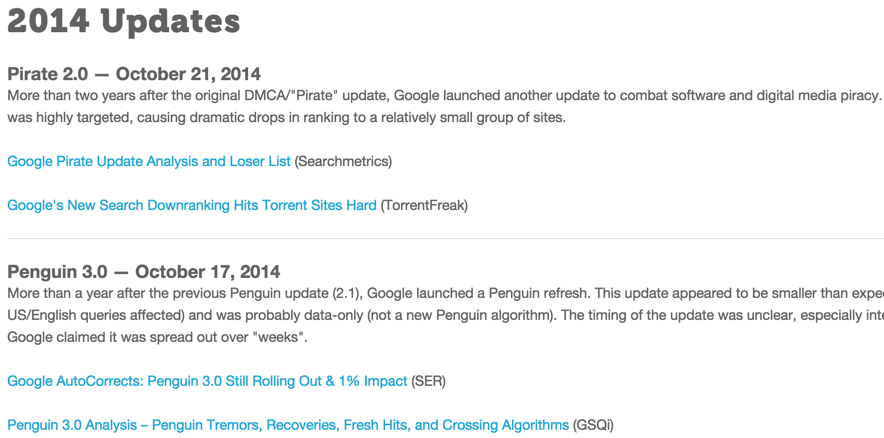 The figure above shows the data on two updates in October. Following the algorithm changes becomes easier through Moz. Users must follow these changes to ensure they’re protecting their gains and taking advantage of new opportunities. Otherwise, you can lose at both.
The figure above shows the data on two updates in October. Following the algorithm changes becomes easier through Moz. Users must follow these changes to ensure they’re protecting their gains and taking advantage of new opportunities. Otherwise, you can lose at both.
Why should I protect the potential?
Link building doesn't work like it used to. The Penguin algorithm of April 24, 2012 became a nightmare for sites with inorganic backlinks. SEOs wanted to protect their sites’ potential while Google made it increasingly difficult for those sites with inorganic backlinks to rank. On one side, websites must be supported with backlinks; on the other side, the algorithms target inorganic structured websites. To clarify this, we will review how Google’s search engine works and how it progresses. Later, we will explain algorithms and penalties.
How Google search works
First of all, you should understand how Google works and what it pays attention to so you understand algorithms and their logic. It would be advantageous to watch Matt Cutts’ video on how Google works:
About algorithms and punishments
Time shifts the attitudes and expectations of users. Malicious websites try to manipulate indexes to get in front of users. Therefore, Google updates their algorithms and identifies the spam to prevent abuse. One of these algorithms called Penguin aims at inorganic backlinks that were bought or hacked, and it penalizes sites that have them. If a site violates Google's guidelines and is negatively affected by Penguin, its owners will have to wait until the next update for a chance to recover. Since its initial release in April 24, 2012, we have seen six total Penguin updates.
 In addition to algorithmic processes, some sites are penalized due to inorganic backlinks as a result of manual analyzes. Though these are very serious, they provide the opportunity to recover after satisfying the analyzer.
In addition to algorithmic processes, some sites are penalized due to inorganic backlinks as a result of manual analyzes. Though these are very serious, they provide the opportunity to recover after satisfying the analyzer.
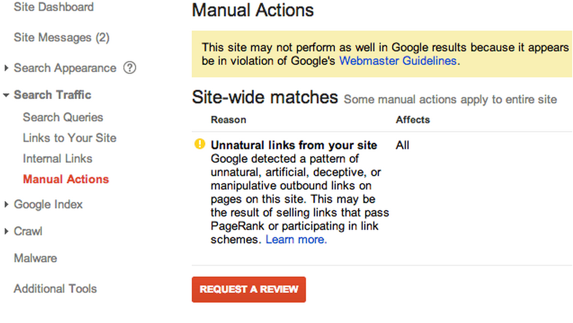 Google analyzes the backlinks of the site with algorithms and manual processes and penalizes websites having inorganic backlinks. Theoretically, you may lose the website which you have spent you months, time and money on after an update or manual process. Don’t let this happen!
Google analyzes the backlinks of the site with algorithms and manual processes and penalizes websites having inorganic backlinks. Theoretically, you may lose the website which you have spent you months, time and money on after an update or manual process. Don’t let this happen!
Negative SEO
You may say, I don't do anything that violates Google's guidelines. Maybe you’re right. But that doesn’t rule out your competitors’ malicious actions (called negative SEO). Dishonest competitors and people may ruin your site in return for payment.  The performance of your website may be affected negatively in seconds with thousands of backlinks coming through various third party tools. For this reason, you should not consider only your actions when it comes to backlink risk management. You must consider and evaluate the actions of dishonest people.
The performance of your website may be affected negatively in seconds with thousands of backlinks coming through various third party tools. For this reason, you should not consider only your actions when it comes to backlink risk management. You must consider and evaluate the actions of dishonest people.
How to persuade the manager?
Managers don’t like loss. Therefore, sell them on how Link Risk Management protects a site from losing traffic and money. Also, sell them on how it improves performance. You will always have to convince someone so make sure you know the facts. Searchmetrics is a perfect measurement tool when used effectively. It could show both the potential revenue and how much you may lose due to a negative situation. One feature of Searchmetrics is the SEO visibility table that shows the performance of all websites in search engines within 2 years. With this feature, you can see the performance losses of websites penalized by a manual spam or algorithmic process. So far we have answered the initial question, What is in it for me? Now we’re going to answer, What if you lose your SEO visibility?
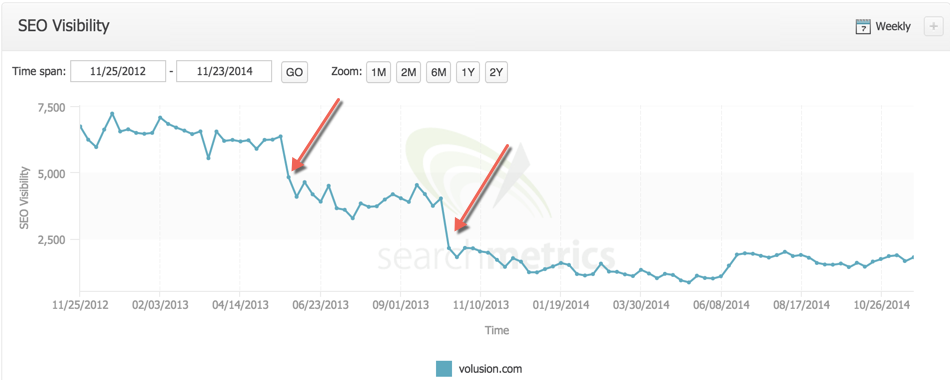 The graphic above shows Volusion.com website's visibility that plummeted thanks to the Penguin 2.0 and Penguin 2.1 updates. Losses on an algorithm timetable are clearly seen.
The graphic above shows Volusion.com website's visibility that plummeted thanks to the Penguin 2.0 and Penguin 2.1 updates. Losses on an algorithm timetable are clearly seen.
Introduction to Searchmetrics' SEO Visibility
The SEO Visibility value of Searchmetrics is a numeric value comprised of the following three metrics:
- The number of keywords of a website listed in search engines
- The positions of the keywords listed
- Tick counts of the keywords
These are updated weekly, and the SEO Visibility chart chronologically displays the performance of a website within past 2 years.
SEO Visibility represents the analysis of a website's performance in search engines. After a comparative analysis between the site and competitor websites, it is possible to observe the balances within the sector. Weekly updates of SEO Visibility charts enable you to follow how websites performed against algorithm updates and/or manual spam actions. Sharp decreases are especially a result of such updates. While trying to convince a prospective customer of Backlink Risk Management, it is advisable to take advantage of the SEO Visibility chart. While you do so, you should point out penalized sites and explain how their losses were avoidable. Reasonable people would see the need for an Link Risk Management strategy.
Exploring the loser list & effects
Searchmetrics announces a weekly updated list in 22 different languages that includes the losers and winners of the week. You can see sharp decreases in the loser list. When you have identified these websites, it will be easier to convince someone of backlink risk management.
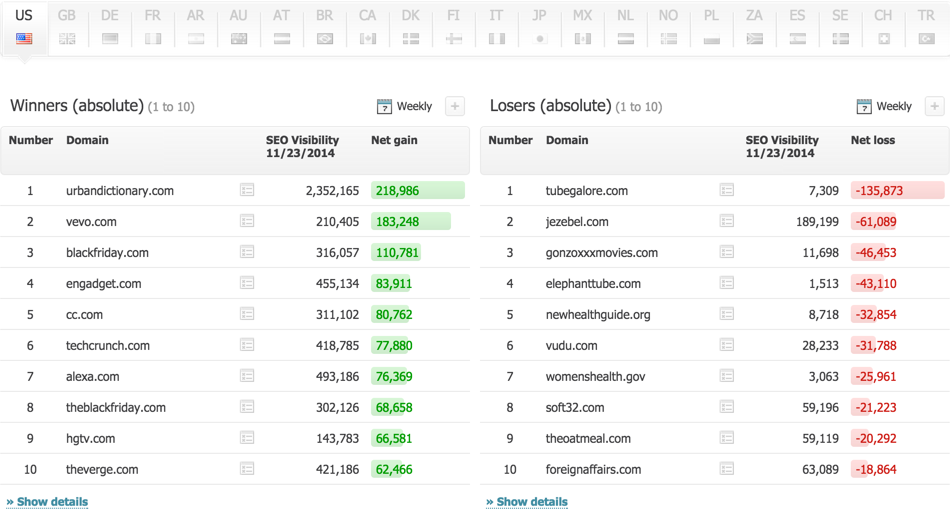 You can analyze the websites that have been penalized after Penguin 2.0, 2.1, and 3.0 versions and state estimated losses.
You can analyze the websites that have been penalized after Penguin 2.0, 2.1, and 3.0 versions and state estimated losses.
Examples of algorithm losers & case studies published on the LRT Blog
In Link Research Tools Case Studies, you can find success stories and horror stories of penalized websites.
- baby-markt.de was a loser after Penguin 2.0.
- HugoBoss.com, following penalizing German Link Networks, lost 39% visibility.
- Expedia.com lost 25% visibility after a Google penalty.
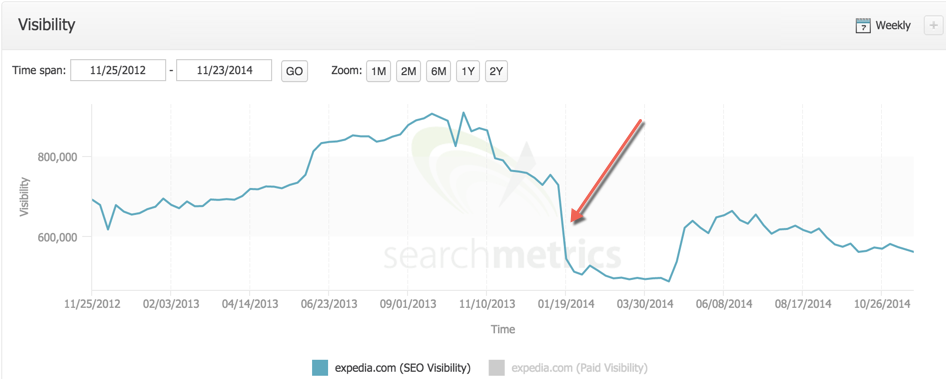
How to protect the potential – Link Risk Management
We explained above how Google works and evolved over time. Now you should understand algorithm updates and how they protect users and provide more accurate research results. We also know how unfavorable the backlinks are. However, some people use these adverse actions against us, which means bad news. Thankfully we can do something about it. We’ve already mentioned it before because it’s sustainable and ensures SEO success. That action is backlink risk management! Backlink risk management means to analyze all backlinks of a website, to categorize risk types and risk status and to protect from malicious, toxic and unnatural links through the Google Disavow Tool. Although it seems confusing at first glance, you only need to join a webinar in order to perform a backlink audit through Link Research Tools. Link Research Tools processes all backlinks of a website using 24 different sources, and it then calculates and estimates the probable link risks and enables you to check out the links. The disavow file, which is created and/or updated following the analysis, ensures that the protection process has been completed! 
About Link Detox
Link Detox Tool and audits all backlinks of a domain. The tool calculates the risks and reports within its 34 rules. The tool is not a part of Google's services and doesn't use Google algorithms. It calculates potential risks based on its huge data set including thousands of processed reports, and customer feedback.
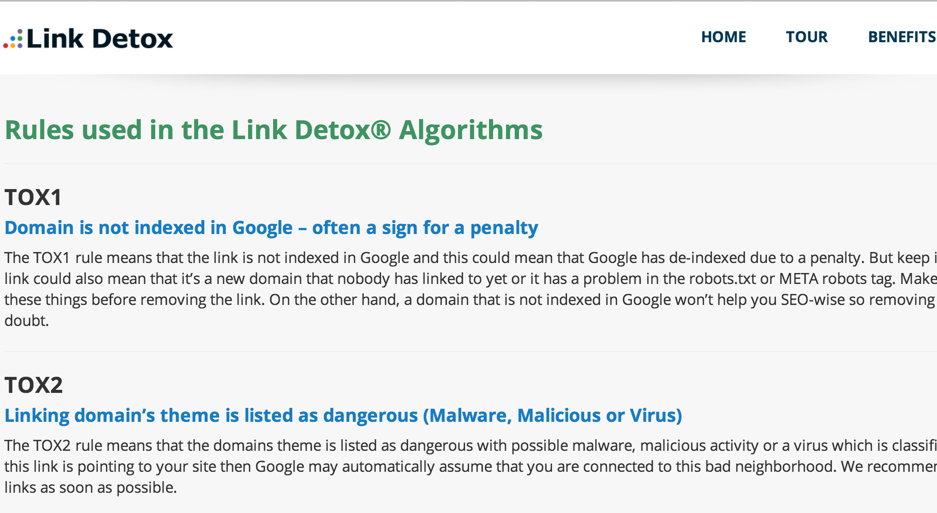
The first step in Link Detox (DTOX) is entering a domain name. You should audit www and non-www versions in order to obtain a more accurate analysis. Make sure that you choose Detox both.
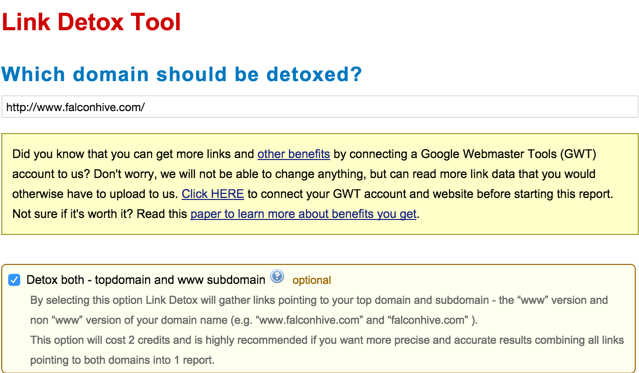
You can specify what you want to analyze through Link Detox. These analyses may be performed on a domain, an index and a page. As our action will be based on domain, we choose domain.

During this process, the tool asks whether we want to include no-follow links in the report. We choose include no-follow links into the report to get more detailed, extensive and accurate analyses.  Choosing the types of websites to be analyzed will ensure more accurate evaluation of the sites.
Choosing the types of websites to be analyzed will ensure more accurate evaluation of the sites.
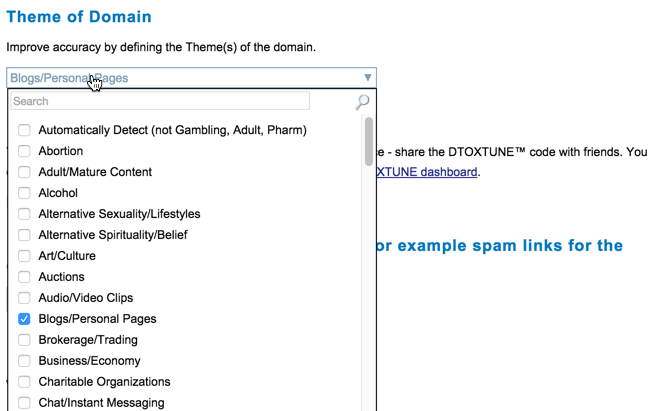
If you have more experience in Link Detox, you can define your own rules for more exact and appropriate results. If you want to perform a standard analysis, you may continue with the default options.

The tool asks whether Google has sent warnings about backlinks or whether a manual spam action has been done. After selecting the appropriate option, we can continue the process.

In the next step, you may perform wide scale analyses by uploading the backlinks you have downloaded from various sources as CSV, .gz or .zip file.

The last step allows you to upload a disavow file which has been added to Google Webmaster Tools. This file, exempted from analyses, creates more exact reports.

Explaining the DTOXRISK
When the Link Detox analysis is finished, Domain-wide DTOXRISK appears. The risks are reported as figures. Risk value, which appears in the first screen, doesn't belong to the domain analyzed. The red result points out high risk.

The Link Detox Tool assesses potential risks of each links. In Link Detox Risk Score (DTOXRISK™) section, you can see risk distribution of the backlinks.

Following the analysis:
- Backlink risk value of a domain analyzed is calculated.
- Backlink risk value of each backlink belonging to domain analyzed is calculated.
How to use the data
Following the analysis process, the data must be processed and controlled judiciously. The first step is to classify anchor texts. For an accurate analysis, 90% links must be classified.

In the new window, you should categorize the anchor texts as follows: Brand: your company name or the company name of your client Money: a service or product like Wordpress Themes Compound: The use of Brand+Money anchor text like FalconHive Wordpress Theme Other: miscellaneous anchor text like click for more or continue
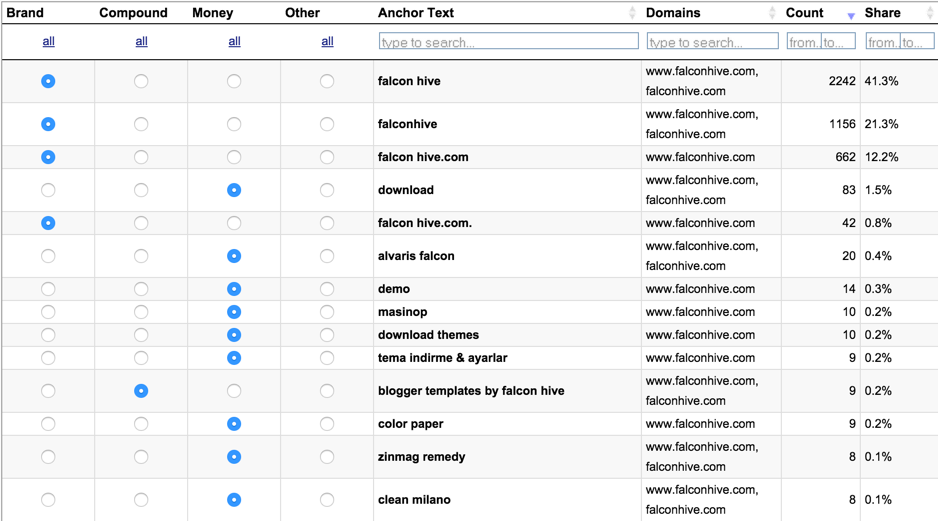
In the following step, you should analyze and classify risk value of the links. During the analyses, it would be practical to use Link Detox Screener.
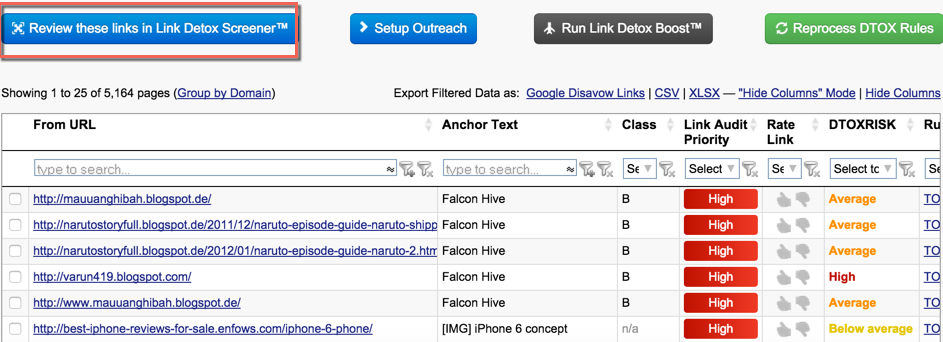
How to read DTOX rules
Prior to analyses, you should prioritize the rules in Link Detox. While Link Detox Screener audits each backlinks, it watches risk values and the rules.

The DTOX Rules page should be kept open until you learn the rules. The rules demonstrate the links’ Link Audit Priority. Even though some rules are stated as a secret source, the information given will be enough for you to evaluate.
Monitoring the backlinks
Through Link Detox Screener, you can preview each link and their DTOXRISK. With shortcut keys, you may move back and forward and ignore the backlinks on the basis of URL or Domain.


Such URL and Domains are placed into the disavow file which is automatically created following the analyses. For this reason, please do not forget to ignore the links with shortcut keys!
Classifying the backlinks
During the Link Detox Screener analysis process, the tags section draws your attention. You are not obliged to use this section during backlink management. However, it doesn't take much time to outline the backlinks and you can visualize which sites you obtain backlinks from.

LRT Expert Derek Devlin shared a tip at an LRT Certified Event in Vienna. If we tag backlinks with alphabetical characters according to their types, it will help create a diagram for backlinks profiles or to distribute backlink profiles (e.g. Blogs -> B).
Generating the disavow file
If you select the option that allows for ignoring the links on the basis of URL or Domain, it makes work easier. When you use the export as disavow file option in the Link Detox report during the analysis process, a disavow file (which includes all the backlinks you want to ignore) will be created automatically. You only need to click the required link!

Afterwards, the disavow file is automatically downloaded to your computer.

Competitive Link Detox to understand the market
We now have completed the backlink audit for the website. You will need to upload the disavow file later. But before that, you must complete a step: sectorial balances! Until now, the analyses have focused on our website. CDTOX tool audits competitor websites in the sector and helps observe the risk balances in the sector. First, enter your domain.

You will see the settings that you are familiar with Link Detox Tool. We select the options about no-follow links.
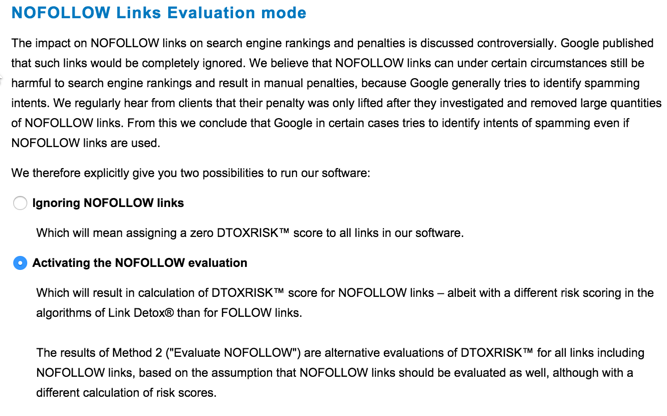
Then, we select the type of the website to be analyzed.

Afterwards we should determine the rules.

We now come to selecting competitor's websites. You can do this process manually or automatically.

After clicking Find Competing Pages link, you should fill in the required blanks to find the competitors.
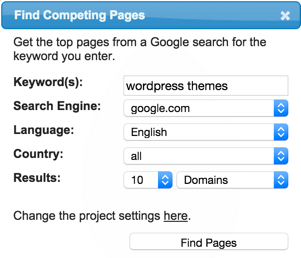
Following entering keywords, we will choose the search engine, then the language and country. As for the Falconhive.com target, we select all the countries and then identify the competitors.
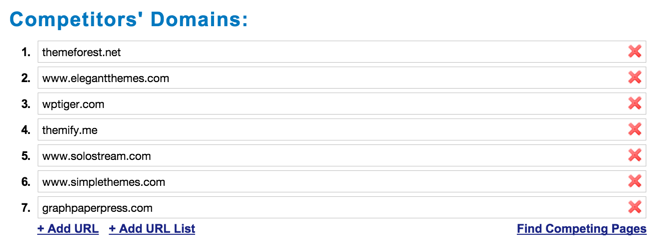
And here are competitors' domains. Now let the analysis begin!
Uploading the disavow file to Link Detox and Re-running the Analysis
After seeing link risk values of the domains in the sector, you should do a proofing analysis. Following completion of the Link Detox Tool analysis, we have created a disavow file with the help of export as disavow file option. This file is uploaded to the system for a new Link Detox analysis and you should observe the decrease in the risk later. In the Link Detox Tool report start page, we will upload the disavow file after adjusting the settings and wait for the results.

If you completed the analysis process and added the links to disavow file, the result will be seen as green. As shown below:

Boosting the Disavow File to Process Faster
After doing the proofing analysis and uploading the disavow file to the system with the use of Google Webmaster Tools, another step must be performed. The links that we ignored come from malicious domains or pages. While some domains are de-indexed from Google, some others hold malwares. It takes months or even years to re-crawl these links. The last step is to use Link Detox Boost that speeds up how soon Google re-crawls the links in your disavow file. In some cases, you can see results within 3 days. Just make sure to wait until 48 hours after uploading the disavow file! In the first step, you will start the process by entering the domain name.

3 Different ways to use Link Detox Boost
There are 3 different ways to upload the links that have been created as a disavow file:
1. Copy and paste the links in the disavow file.
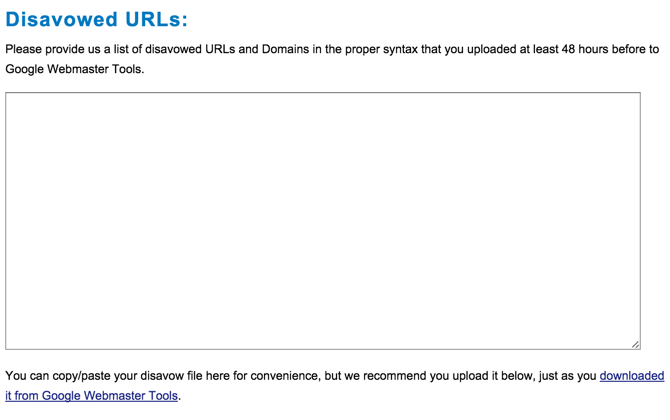
2. Use the disavow file within LinkResearchTools’ indexes. (During the proofing analysis with Link Detox, it will be automatically identified on the disavow file settings page since we already uploaded the disavow file to the system.)


3. Upload the disavow file from your computer.

For re-running Link Detox, we begin the report with the second option selected since the disavow file has been uploaded to the system before. The tool processes the links faster. Following this step you can see when Google has crawled the disavowed links.
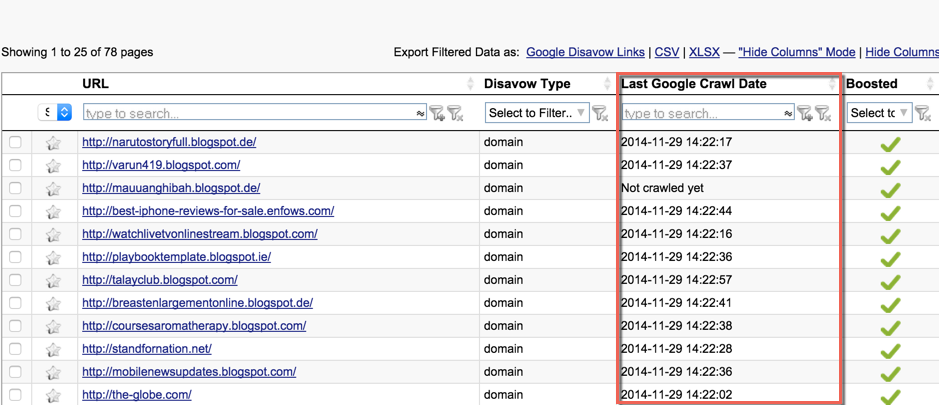
Link Alerts; Keep an eye on new spammy links!
All done? Not quite. Removing the risk relieves the present crisis. Next you need to create an alert mechanism with Link Alerts to warn you when new backlinks are built to your domain without your knowledge. It may be the only warning you get of a potential attack! Firstly, enter the domain name.

Then, select the backlink source.
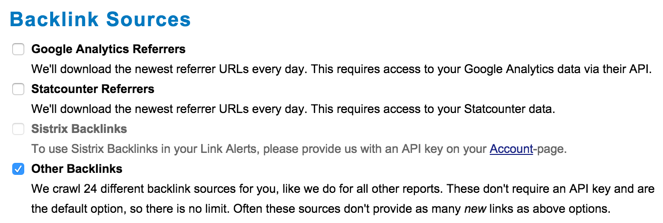
Although backlink sources include Google Analytics Referrers and Statcounter Referrers, it would be more rewarding to build an alert system against the data coming from 24 various sources. Clicking the Start Link alerts button, we have established an early warning mechanism. New links will be automatically sent to your e-mail address. You could also follow the situation on the Link Alerts page any time.
That is end of the story!
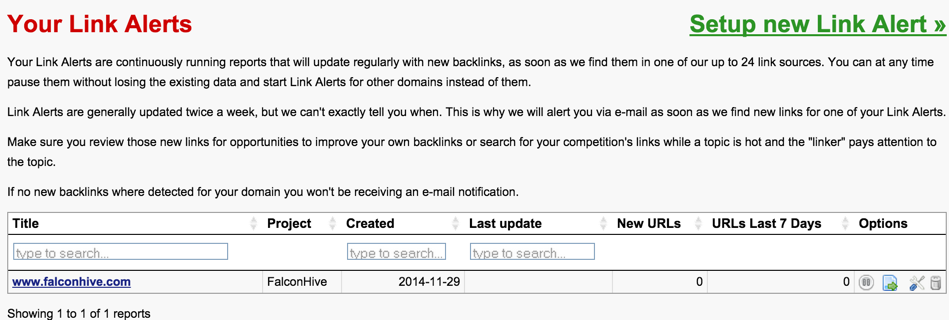
Summary
Falconhive.com that has been mentioned in this analysis is one of my friend’s projects. With his permission, I will share a month of its Google Analytics data.
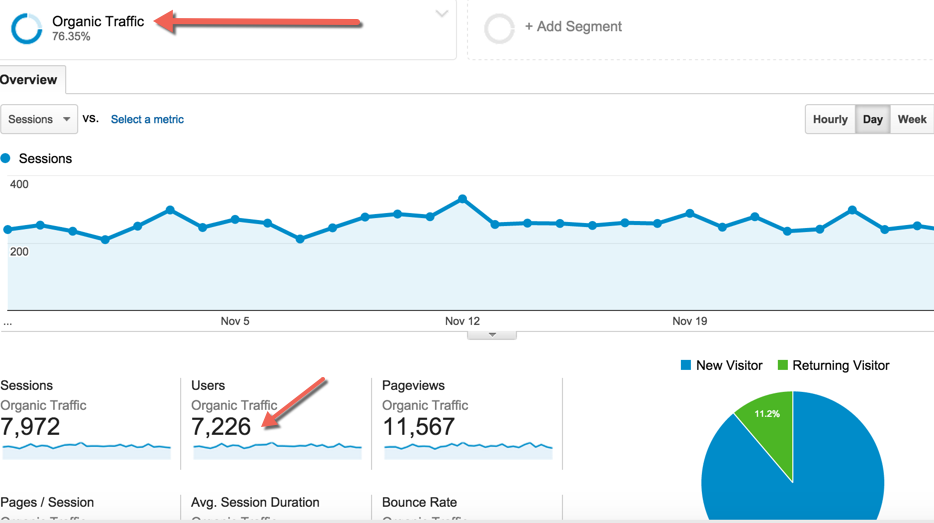
When we look at the website's traffic, we notice that the figure is not bad for the sector. As for the link audit process, the website may be penalized due to links that holds high risk value, but go unnoticed. Following the analysis performed through Link Detox, we:
- Audited all links through Link Detox Screener
- Ignored links on the basis of URL or domain (according to risk status of the links)
- Categorized the links
- Created a disavow file
After the analysis process, we reviewed the risk scores of domains in the sector and found sectorial balances. For the proofing process, we re-ran the Link Detox Tool.
However, we uploaded the disavow file to the system and excluded disavowed links from the analysis process. Afterwards, we noticed a decrease in domain risks.
Since we know that it takes too much time to re-crawl malicious links, we used Link Detox Boost for faster results. Now we have completed the audit process required for Link Risk Management. Plus, we built an early warning mechanism with the help of Link Alerts to keep future links under control.
Link building should always be kept updated because it unfortunately poses risks to your site’s performance.
Controlling risk status is simple through Link Research Tools. As long as you keep risks under control, adverse effects from malicious actions will be minimized.
Slip up, let your guard down, and you may lose it all.
It’s up to you!
**This case study was written by Arda Mendes, SEO Consultant, and proud user of LinkResearchTools and Link Detox.
A word from Christoph C. Cemper
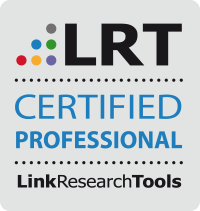
This analysis was conducted and written by LRT Certified Professional, Arda Mendes, who has taken the next step to become a Certified LinkResearchTools Xpert. Arda continues to demonstrate his SEO expertise by giving us easy tips to explain to your clients or boss the reasons needed for proper Link Risk Management. Our goal is to provide our user community and clients with quality service and knowledge. Our LRT Certified Professionals are key to achieving this goal. I look forward to his future work, and personally recommend working with Arda Mendes whenever you get the opportunity!
